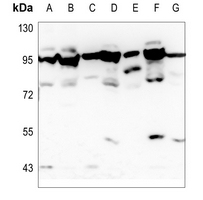Anti-OATP1 Antibody
Rabbit polyclonal antibody to OATP1
- SPECIFICATION
- CITATIONS
- PROTOCOLS
- BACKGROUND

Application
| WB, IP |
|---|---|
| Primary Accession | P46721 |
| Reactivity | Human, Mouse, Rat |
| Host | Rabbit |
| Clonality | Polyclonal |
| Calculated MW | 74145 Da |
| Gene ID | 6579 |
|---|---|
| Other Names | OATP; OATP1; OATP1A2; SLC21A3; Solute carrier organic anion transporter family member 1A2; OATP-A; Organic anion-transporting polypeptide 1; OATP-1; Sodium-independent organic anion transporter; Solute carrier family 21 member 3 |
| Target/Specificity | KLH-conjugated synthetic peptide encompassing a sequence within the center region of human OATP1. The exact sequence is proprietary. |
| Dilution | WB~~WB (1/500 - 1/1000), IP (1/10 - 1/100) IP~~N/A |
| Format | Liquid in 0.42% Potassium phosphate, 0.87% Sodium chloride, pH 7.3, 30% glycerol, and 0.09% (W/V) sodium azide. |
| Storage | Store at -20 °C.Stable for 12 months from date of receipt |
| Name | SLCO1A2 |
|---|---|
| Synonyms | OATP, OATP1, OATP1A2, SLC21A3 |
| Function | Na(+)-independent transporter that mediates the cellular uptake of a broad range of organic anions such as the endogenous bile salts cholate and deoxycholate, either in their unconjugated or conjugated forms (taurocholate and glycocholate), at the plasmam membrane (PubMed:19129463, PubMed:7557095). Responsible for intestinal absorption of bile acids (By similarity). Transports dehydroepiandrosterone 3-sulfate (DHEAS), a major circulating steroid secreted by the adrenal cortex, as well as estrone 3-sulfate and 17beta-estradiol 17-O-(beta-D-glucuronate) (PubMed:11159893, PubMed:12568656, PubMed:19129463, PubMed:23918469, PubMed:25560245, PubMed:9539145). Mediates apical uptake of all-trans-retinol (atROL) across human retinal pigment epithelium, which is essential to maintaining the integrity of the visual cycle and thus vision (PubMed:25560245). Involved in the uptake of clinically used drugs (PubMed:17301733, PubMed:20686826, PubMed:27777271). Capable of thyroid hormone transport (both T3 or 3,3',5'-triiodo-L-thyronine, and T4 or L- tyroxine) (PubMed:19129463, PubMed:20358049). Also transports prostaglandin E2 (PubMed:19129463). Plays roles in blood-brain and -cerebrospinal fluid barrier transport of organic anions and signal mediators, and in hormone uptake by neural cells (By similarity). May also play a role in the reuptake of neuropeptides such as substance P/TAC1 and vasoactive intestinal peptide/VIP released from retinal neurons (PubMed:25132355). May play an important role in plasma and tissue distribution of the structurally diverse chemotherapeutic drugs methotrexate and paclitaxel (PubMed:23243220). Shows a pH-sensitive substrate specificity which may be ascribed to the protonation state of the binding site and leads to a stimulation of substrate transport in an acidic microenvironment (PubMed:19129463). Hydrogencarbonate/HCO3(-) acts as the probable counteranion that exchanges for organic anions (PubMed:19129463). May contribute to regulate the transport of organic compounds in testis across the blood-testis-barrier (Probable). |
| Cellular Location | Cell membrane; Multi-pass membrane protein. Basal cell membrane; Multi-pass membrane protein. Note=Localized to the basal membrane of Sertoli cells. |
| Tissue Location | Higher expression in the brain than in liver and kidney (PubMed:15632119, PubMed:7557095, PubMed:9539145). Expressed in brain neurons in both cortex and hippocampus (PubMed:10873595, PubMed:25132355). Expressed in placental trophoblasts (PubMed:12409283). Also expressed in lung and testes at lower levels (PubMed:7557095). Expressed in the eye (at protein level) (PubMed:25560245). Expressed in the retina in the outer and inner nuclear layers, the inner plexiform layer and the ganglion cell layer (PubMed:25132355). Expressed in liver and prostate (PubMed:10873595) In testis, primarily localized to the basal membrane of Sertoli cells and weakly expressed in Leydig cells and within the tubules (PubMed:35307651). Expressed in fetal brain and liver (PubMed:10873595). |

Thousands of laboratories across the world have published research that depended on the performance of antibodies from Abcepta to advance their research. Check out links to articles that cite our products in major peer-reviewed journals, organized by research category.
info@abcepta.com, and receive a free "I Love Antibodies" mug.
Provided below are standard protocols that you may find useful for product applications.
Background
KLH-conjugated synthetic peptide encompassing a sequence within the center region of human OATP1. The exact sequence is proprietary.
If you have used an Abcepta product and would like to share how it has performed, please click on the "Submit Review" button and provide the requested information. Our staff will examine and post your review and contact you if needed.
If you have any additional inquiries please email technical services at tech@abcepta.com.













 Foundational characteristics of cancer include proliferation, angiogenesis, migration, evasion of apoptosis, and cellular immortality. Find key markers for these cellular processes and antibodies to detect them.
Foundational characteristics of cancer include proliferation, angiogenesis, migration, evasion of apoptosis, and cellular immortality. Find key markers for these cellular processes and antibodies to detect them. The SUMOplot™ Analysis Program predicts and scores sumoylation sites in your protein. SUMOylation is a post-translational modification involved in various cellular processes, such as nuclear-cytosolic transport, transcriptional regulation, apoptosis, protein stability, response to stress, and progression through the cell cycle.
The SUMOplot™ Analysis Program predicts and scores sumoylation sites in your protein. SUMOylation is a post-translational modification involved in various cellular processes, such as nuclear-cytosolic transport, transcriptional regulation, apoptosis, protein stability, response to stress, and progression through the cell cycle. The Autophagy Receptor Motif Plotter predicts and scores autophagy receptor binding sites in your protein. Identifying proteins connected to this pathway is critical to understanding the role of autophagy in physiological as well as pathological processes such as development, differentiation, neurodegenerative diseases, stress, infection, and cancer.
The Autophagy Receptor Motif Plotter predicts and scores autophagy receptor binding sites in your protein. Identifying proteins connected to this pathway is critical to understanding the role of autophagy in physiological as well as pathological processes such as development, differentiation, neurodegenerative diseases, stress, infection, and cancer.


